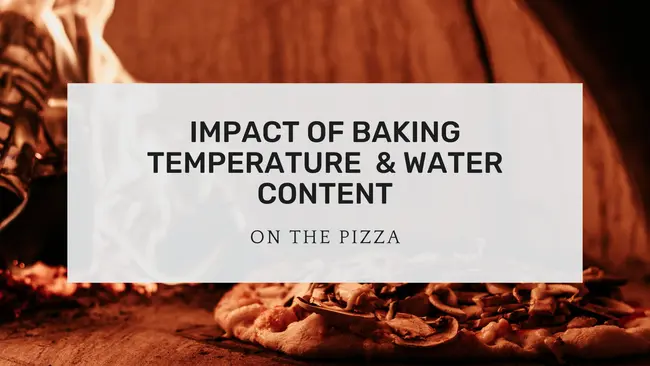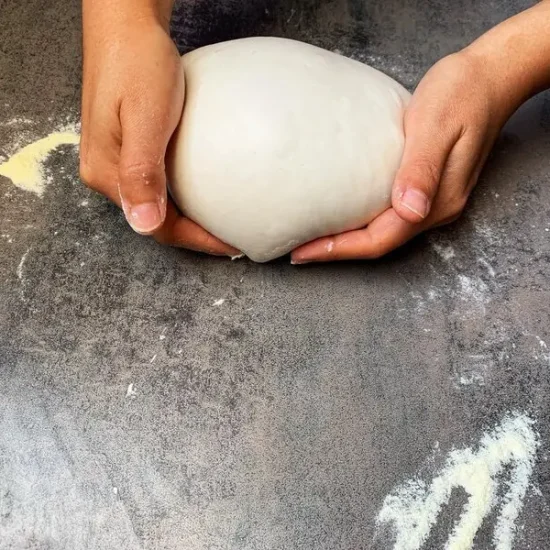I am often asked by my readers: what is the best way to bake a Neapolitan pizza at home in my oven or in my backyard grill? My answer is: the pizza you make at home or in your grill probably won’t taste or look like a Neapolitan pizza from a 500 degree oven. But you can at least come close to it if you understand how temperature and water content affect pizza dough. That’s exactly what I want to explain in this post.
What kind of pizza do I want to eat?
First of all, however, you should ask yourself: what kind of pizza do I want to eat? How should it taste, what consistency should it have? A soft one that can be folded, like the Neapolitan pizza? Do I want the crust to be crispy, but the crumb to be soft like a Pizza in Teglia (Roman-style sheet pizza)? Or should it be paper-thin and crispy?
Baking temperature & water content in the dough
Next, it is important to keep in mind that the water content in the dough and the oven temperature are closely related, and this relationship determines how the pizza will ultimately come out.
Example Neapolitan pizza: the original recipe calls for a water content of 55.5% (1 liter of water per 1.8 kg of flour). This is a comparatively “dry” dough. Since the pizza is baked at about 485 degrees, it takes only about 60-90 seconds to be cooked through. The pizza will be soft, elastic and foldable.
However, if you bake the same dough in a conventional household oven at about 250 degrees, the pizza will take more time to bake through due to the lower temperature, about 7 minutes on average. Taste-wise, it will be rather dry and crispy compared to traditional Neapolitan pizza, which bakes at 485 degrees. Why is that? More moisture is removed from the dough in 7 minutes of baking at 250 degrees than in 60 seconds at 485 degrees. The longer the dough bakes in the oven, the more moisture it loses – ergo, the drier and crispier it will be.
Neapolitan style pizza in the household oven
So, to imitate the soft and foldable consistency of a Neapolitan pizza at home in the household oven, you should increase the water content in the dough, e.g. to 70% (= 700 ml water to 1 kg flour). More water in the dough will make the pizza less dry and crispy during the baking time of 7 minutes at 250 degrees. It will probably not taste completely identical to an original Neapolitan pizza, but will be slightly crispier, but it will have a great soft and airy crumb compared to the dough with 55% water.
The only thing to bear in mind here is that a dough with a high water content also needs the right flour, you can find more information on the right pizza flour here.
Thick pizza with crispy base
However, if you want to eat a thicker pizza with a crispy base and soft crumb like the pizza in teglia (Roman-style sheet pizza), whose dough has a very high water content, it is better to bake it at lower temperatures like those of a domestic oven than in a blazing hot pizza oven. The lower temperature of the household oven makes it possible for the thicker and wetter dough to bake completely through without burning the outside.
Thin and crispy pizza
If, on the other hand, you fancy a paper-thin and crispy pizza (or similar: tarte flambée), you can use a dough with a low water content (e.g. 60%), roll it out thinly and bake it at approx. 250 degrees for 6 – 8 minutes.
Pizza from the grill
In a grill it can also be different again: the cooking chamber of the grill can reach at least 300 degrees, with a pizza stone even 350 degrees. At these temperatures you bake a Neapolitan-style pizza for about 3.5 minutes.
Summary
In higher temperature ovens (400 degrees upwards) the dough bakes through faster, the water has less time to evaporate and the result is an overall softer consistency of the pizza. Ovens with a lower temperature (household ovens with a maximum of 250 – 270 degrees) bake the dough more slowly, but the water has more time to evaporate, resulting in an overall crispier consistency of the pizza. Now that you know how the water content in the pizza dough interacts with the baking temperature, you can tailor your pizzas much more individually to your needs in the future.
Discover more
You’d like to start making pizza right away, but you’re wondering where to start? We have summarized the most important information on the following page for you.
Thanks for reading! I hope this article about the impact of the baking temperature and water content on your pizza was valuable to you. If you have any unanswered questions, feel free to let me know in the comments. I’d appreciate it if you could share this article with your friends.
Julia




